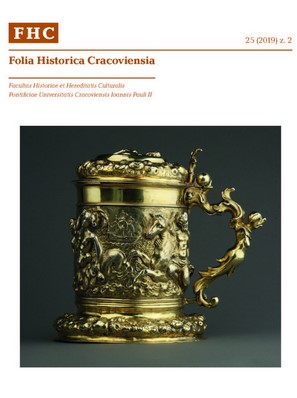The Characteristics of Italian Collections of Gilt Leather as an Element of the Research into the Provenance of the Gilt-Leather Wall Hangings in Wawel Royal Castle
The Characteristics of Italian Collections of Gilt Leather as an Element of the Research into the Provenance of the Gilt-Leather Wall Hangings in Wawel Royal Castle
Author(s): Ojcumiła Sieradzka-MalecSubject(s): Cultural history, Visual Arts, 18th Century, History of Art
Published by: Wydawnictwo Naukowe Uniwersytetu Papieskiego Jana Pawła II w Krakowie
Keywords: gilt leather; gilt leather wall hangings; Italian collections of gilt leather; wall coverings; cordovan; Wawel Royal Castle in Kraków; Poland; interior decoration;
Summary/Abstract: Wawel Royal Castle is a home to a large collection of gilt-leather wall hangings from the Baroque period (1720s). Purchased from the Moritzburg Castle of Elector of Saxony and King of Poland Augustus II the Strong in the 1930s., they were not the original furnishings of the Wawel Castle. Among the diverse issues concerning these wall hangings, the question of its provenience has not been thoroughly studied yet. Starting with an indication of the ruler’s interest in gilt-leather wall hangings from Venice, I present collections from several regions of Italy. The collection of gilt-leather in the Palazzo Chigi of Ariccia is the largest in Europe. Thanks to the preserved archives of the family, the place of their manufacture can be pinpointed: Roman workshops, the names of the artisans, and exact age, which is truly exceptional. With respect to other collections in Rome, as well as in Umbria, Tuscany and Bologna, information on the works’ origin or even their place and source of purchase are usually missing. In Florence, two museums, the Stefano Bardini and the Stibbert, house larger collections of gilt-leather wall hangings, reflecting antiquarian efforts in the second half of the 19th century. The Italian gilt-leather wall hangings are older than those from Krakow, as most of them date back to the 17th century, and they differ in their ornamentation and style. The decoration (pattern, motifs) reflects the designs used in textiles. Regretfully, the studied and presented material lacks examples of gilt-leather wall hangings which would match the ones from Wawel Castle in their decorative aspect. From the technological point of view, the Krakow gilt-leather wall hangings are mainly Italian, of the flat variety, diversified by punching, with painted ornaments. However, the technological aspects do not determine the place of their manufacture, as similar flat gilt-leather wall hangings were produced in other European countries as well. Similarly, the types of punching do not constitute a geographic distinguishing feature. In light of the above, the issue needs further studies, particularly in the scope of the operations of Venice workshops.
Journal: Folia Historica Cracoviensia
- Issue Year: 25/2019
- Issue No: 2
- Page Range: 45-76
- Page Count: 32
- Language: English

